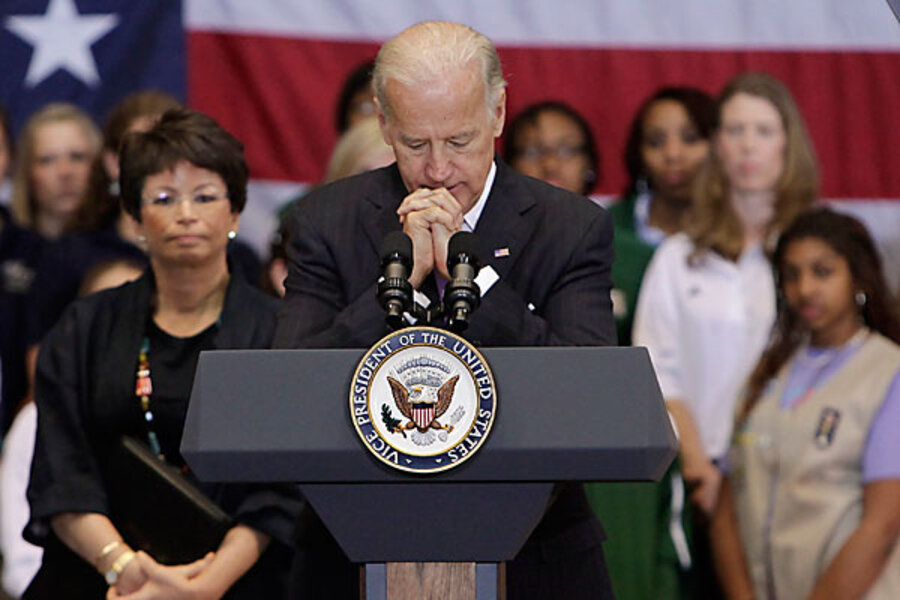College sports: White House tweaks Title IX rules
Loading...
Colleges can no longer rely on a survey for female students – designed to gauge their interest in athletics – to show that they are compliant with Title IX requirements.
Vice President Joe Biden made the announcement Tuesday about the so-called model survey. The new policy essentially rescinds a 2005 rule that critics said allowed colleges to duck out of the gender-equity law.
"Making Title IX as strong as possible is a no-brainer,” Mr. Biden said. “What we're doing here today will better ensure equal opportunity in athletics and allow women to realize their potential – so this nation can realize its potential."
While many women’s groups and the NCAA laud the change, others say it is a disappointing move that pushes colleges even more toward quotas and number requirements in athletics. A lack of flexibility often means that less-popular sports for both men and women simply get cut.
Title IX demands gender equity for programs that receive federal education money. Under it, colleges have had three ways to show they are compliant when it comes to sports: demonstrating that women’s participation is proportional to their enrollment, showing that the school is expanding the number of sports teams for women (which defers the need for proportional compliance by several years), or showing that the school is meeting the interests and abilities of women on campus.
Traditionally, showing “proportionality” has been the most widely used method. Many colleges see it as the most foolproof way to avoid a lawsuit.
The 2005 rule allowed schools to meet the requirements of the third prong by using an e-mailed survey to female students, asking them about their athletic interests. No response was considered to indicate a lack of interest, which essentially meant that the college in question had fewer requirements placed on it.
“The 2005 policy that was withdrawn today was very damaging,” says Neena Chaudhry, senior counsel for the National Women’s Law Center. “It gave schools an easy way out: It gave them a loophole for them to comply. Today’s policy restores the law and requires schools to look at a whole host of factors and prove they’re satisfying women’s interests.”
Still, some critics of Tuesday’s decision say that the model survey was a useful way to gauge interest. They suggest that offering it as part of course registration, instead of by e-mail, might have dealt with the no-response issue.
In addition, they worry that the new rule will push more schools to use proportionality as the best defense against a lawsuit.
“What it boils down to is flexibility,” says Eric Pearson, chairman of the College Sports Council, who says he sees proportional compliance as little more than a quota system. In particular, he cites historically black colleges – where women often outnumber men 2 to 1 – as having a hard time with proportionality. And he worries about the lack of recourse that men have when their sports are cut, as was the case with the men’s wrestling team at Delaware State University two years ago. (The women’s equestrian team, eliminated at the same time, was restored following a lawsuit, but the wrestling team stayed on the chopping block.)
Mike Moyer, executive director of the National Wrestling Coaches Association, agrees. A side effect of Title IX, he notes, is that small-roster sports for both men and women are often cut.
“What better way to assess the interests of students on campus than to ask them?” he says, adding that he’d like to see both men and women surveyed about their sports interests.
Yet that third prong to demonstrate compliance is still in place, and proponents of Tuesday’s decision, like Ms. Chaudhry, note that schools are still welcome to use surveys, as long as they don’t rely on a survey alone. Rather, they must use a variety of factors to show that the school is meeting students’ interests and abilities.
Getting rid of the 2005 rule was an important step, Chaudhry says. Now, she hopes that the Department of Education will also step up enforcement – which officials promised to do Tuesday.
"There is no doubt that Title IX has dramatically increased athletic, academic, and employment opportunities for women and girls, and educational institutions have made big strides in providing equal opportunities in sports," said Secretary Arne Duncan, who spoke at the event with Biden. "Yet discrimination continues to exist in college athletic programs – and we should be vigilant in enforcing the law and protecting this important civil right."





